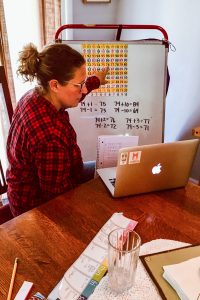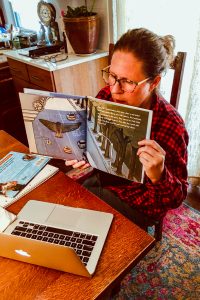Embedded journalism refers to the work of writers or photographers who spend a considerable amount of with their subject, such as reporters who are assigned to a military unit or an exploration or some other long-term story. The DMPS communications team has its own embedded journalist of sorts: staff writer Mike Wellman has spent the past two months at home with his wife Chris, a first grade teacher at Phillips Elementary School. Mike shares this first-hand account from a “classroom” in the time of Coronavirus, and how teachers are dedicated to their students no matter the circumstances.
Instead of driving across town in rush hour traffic, all she has to do is take a seat in her dining room. Barely big enough for a family dinner, now it’s doubling as a virtual classroom for Chris Wellman and her 21 students from Phillips Elementary School. A whiteboard easel has taken the place of the linens cupboard.
Monday was what passes now for a typical day in the life of a DMPS teacher, post-COVID closure. For “Mrs. Wellman” as she’s known to her class, it was a busy mix of professional development, student conferences and collegial collaboration.
Between morning and afternoon online PD sessions delivered by EL, the new elementary curriculum model the district adopted this year that we reported on in January, she got face to face with students in groups of two or three at a time. Those sessions were opportunities to brush up on schoolwork, but at least as importantly, they were interpersonal reunions.
“Relationships are what we miss,” said Wellman. “They are the key to teaching and learning.”
Teachers and students don’t necessarily miss the math and reading they work on together. They miss each other.
Virtual read-alouds made possible by tech networks like Microsoft Teams and the district’s CANVAS curriculum platform are somewhat akin to substitute teachers compared to a class sprayed across the rug in front of Wellman’s rocking chair in Room 106. Except there is no substitute for the fact that this teacher and these kids do know each other. The enthusiasm they share for one another is one element that’s not completely lost in transition from close range to distant learning. You can hear it in voices and see it in faces. If only you could touch it.
“We need to be with them, though,” said Wellman. “The human touch is so important to making six-year-olds not only understand you, but feel safe with you. That sense of safety is critical.”
Teachers and students are like dance partners, especially in the primary grades, old-fashioned lead and follow steps. That’s a tough synergy to recreate via 2D virtuality.
Like teachers districtwide, Wellman returned to school to help distribute computers before the launch of the distant learning effort last month. It was a bittersweet experience, a case of so close and yet so far. One of her students arrived in a van from his daycare provider and he ran to the front, excited to reconnect with his teacher, only to burst into tears when he realized that it was a look but don’t touch moment.

Everything but an apple: dining room and kitchen tables throughout Des Moines are now serving as teachers’ desks.
“It’s been hard on both sides,” said Wellman.
Not to mention the diluted sense of collegiality when teachers can’t gather as teammates at their building.
“We establish professional and personal support systems with each other,” Wellman said.
Those, too, have been virtualized. Much has been made, naturally, of what’s being denied the Class of 2020. But teachers are also going through rites of passage that are once-in-a-lifetime. Wellman has colleagues, for instance, who are rescheduling weddings and retiring after decades in the classroom. Group Zooms and horn honks in slow parades can’t carry the poignancy those occasions warrant.
“We miss our people,” said Phillips Instructional Coach Carrie Ratliff. “These ladies are my people. They get me, they take me as I am and make me a better person. I miss the hair-pulling frustration, the knowing smiles across the hall, the small gestures of kindness and the laughter we share that is so great it brings you to tears.”
Closure is the word most often used in reference to the premature shutdown of the school year. But 2019-20 lacks the usual sense of that word, the countdown dynamic that is such a big part of regularly scheduled last days. Wellman got a shred of it when she took her assigned turn returning to her classroom to tie up loose ends and retrieve some essentials necessary for even distant teaching, like the easel. And she already had her class hamster and newts at home for safekeeping. But the lack of a shared final day leaves all concerned with an odd sensation of unfinished business, like a confusing final scene of a foreign film.
Not everything is different, though.
When Adam interrupts a read-aloud from City Hawk to say he’s got to go to the bathroom, Mrs. Wellman grants permission. “Just like regular school,” she thinks out loud, like a talk show host assuming they’ve gone to commercial.
“Yeah, it is,” Adam giggles, before away he goes.







